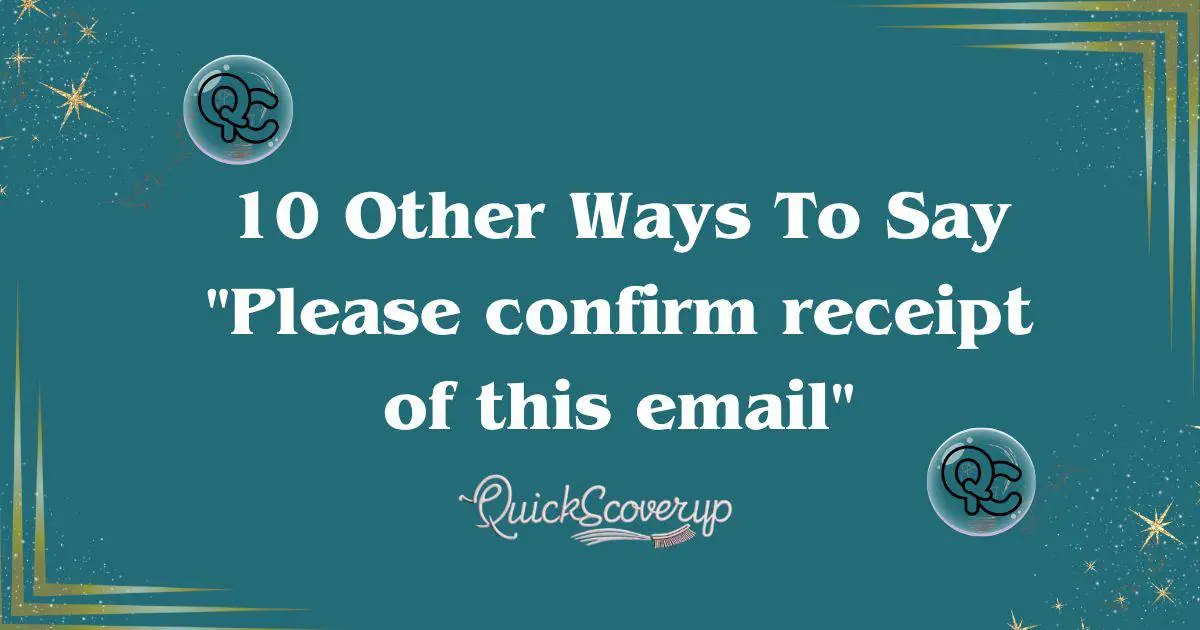“Please confirm receipt of this email” is a phrase often used to ensure that the recipient has received and acknowledged an important email. It is commonly used in business or formal communication. This phrase helps avoid miscommunication and ensures smooth interactions.
Have you ever sent an email and wondered if it reached its destination? That’s where “please confirm receipt of this email” comes in handy. By requesting confirmation, you stay informed and avoid any uncertainty in your professional exchanges.
In many cases, confirmation helps track important messages. It is a polite and effective way to ensure clarity. Using this phrase can also protect you from future misunderstandings.
The Etiquette of “Please Confirm Receipt”
Using this phrase shows professionalism and ensures the recipient acknowledges important information. It’s polite and typically reserved for formal communication or when time-sensitive details are involved.
When It’s Appropriate to Use
In the realm of formal communication, asking for confirmation that an email has been received can be a powerful tool. But like any tool, it’s most effective when used judiciously. Consider using this request when:
- Sending important info or time-sensitive communications
- Attaching significant attachments like contracts or proposals
- Providing detailed instructions for a critical task
- Communicating with new clients or partners for the first time
Potential Benefits
- Ensuring Critical Information is Received: In high-stakes situations, knowing your message has landed can provide peace of mind.
- Maintaining Accountability: A confirmation creates a paper trail, which can be crucial in professional settings.
- Streamlining Communication: It reduces the need for follow-up emails, saving time for both parties.
Possible Drawbacks
- Perceived as Pushy: Overuse can make you seem demanding or distrustful.
- Potential to Annoy: Busy recipients might find constant requests for confirmation irritating.
- Diminished Impact: If you ask for confirmation on every email, it loses its significance.
“The art of communication is the language of leadership.” – James Humes
Crafting the Perfect Request
When it comes to asking for confirmation, context is king. Your approach should vary depending on the formality of the situation, your relationship with the recipient, and the urgency of the matter at hand.
Tone Considerations
In formal settings, your language should be polite and professional. For more casual work relationships, a friendlier tone might be appropriate. Always err on the side of formality when in doubt.
Context Matters
Consider the following factors:
- The recipient’s position and your relationship with them
- The importance and urgency of the email content
- Cultural norms and industry standards
Tailoring to Your Relationship
| Relationship Type | Example Phrase |
| New Client | “I would greatly appreciate a brief acknowledgment of receipt.” |
| Long-term Colleague | “Mind dropping me a quick ‘got it’ when you can?” |
| Superior | “If you could confirm receipt at your earliest convenience, I’d be most grateful.” |
10 Polite Alternatives to “Please Confirm Receipt”
For Formal Situations
- “I’d be grateful for a brief acknowledgment of receipt.” Example: “Attached please find the Q3 financial report. I’d be grateful for a brief acknowledgment of receipt.”
- “Kindly confirm when this message reaches you.” Example: “The updated contract is enclosed. Kindly confirm when this message reaches you.”
For Semi-Formal Contexts
- “A quick note to confirm you’ve got this would be great.” Example: “I’ve outlined the project milestones in this email. A quick note to confirm you’ve got this would be great.”
- “Mind dropping me a line when you get a chance to read this?” Example: “I’ve made some suggestions for the team outing. Mind dropping me a line when you get a chance to read this?”
For Casual Correspondence
- “Give me a shout when this pops into your inbox!” Example: “I’ve sent over those photos from the company picnic. Give me a shout when this pops into your inbox!”
- “Just checking – did this email make it to you okay?” Example: “Hey! I sent some ideas for the new logo yesterday. Just checking – did this email make it to you okay?”
For Follow-ups
- “Following up – did my previous email find its way to you?” Example: “I’m following up on the budget proposal I sent last week. Did my previous email find its way to you?”
- “Just circling back to ensure my last message didn’t get lost in cyberspace.” Example: “I haven’t heard back about the client meeting. Just circling back to ensure my last message didn’t get lost in cyberspace.”
For Time-Sensitive Matters
- “As this is time-sensitive, please confirm receipt ASAP.” Example: “The deadline for the grant application is tomorrow. As this is time-sensitive, please confirm receipt ASAP.”
- “Given the urgency, I’d appreciate a quick confirmation.” Example: “We need to respond to the auditors by EOD. Given the urgency, I’d appreciate a quick confirmation.”
Practical Examples in Context
Scenario 1: Sending Important Documents
Subject: Urgent: Q4 Financial Report for Board Review
Dear Ms. Johnson,
I hope this email finds you well. Attached please find the Q4 Financial Report for the upcoming board meeting. As this document contains critical information for our discussion, I would greatly appreciate it if you could confirm receipt of this email and its attachment.
If you have any questions or concerns about the report, please don’t hesitate to reach out.
Best regards, John Smith
Scenario 2: Following Up on an Unanswered Email
Subject: Follow-up: Project Titan Proposal
Hi Tom,
I’m just circling back on the Project Titan proposal I sent over last Thursday. I wanted to ensure it didn’t get lost in the shuffle of end-of-week emails. When you get a moment, could you let me know if you’ve had a chance to review it?
I’m eager to hear your thoughts and move forward with the next steps.
Thanks, Sarah
Scenario 3: Confirming Receipt of Project Details
Subject: Project Zenith: Kick-off Meeting Details
Dear Team,
I’ve just sent out the calendar invite for our Project Zenith kick-off meeting next Tuesday. The invite includes crucial information about our objectives, timeline, and individual responsibilities.
Given the importance of this project, I’d appreciate a quick reply to confirm you’ve received this information and will be attending the meeting.
Looking forward to getting started!
Best, Alex
The Psychology Behind Confirmation Requests
Understanding the psychological aspects of confirmation emails can help you use them more effectively and empathetically in your professional communication.
Building Trust and Rapport
When used appropriately, confirmation requests can demonstrate:
- Attention to detail: Showing that you care about ensuring smooth communication
- Respect for the recipient’s time: Acknowledging the importance of their input or response
- Professionalism: Exhibiting thoroughness in your business correspondence
Reducing Anxiety and Uncertainty
In high-stakes or time-sensitive situations, knowing your message has been received can:
- Alleviate stress about whether crucial information has been communicated
- Provide a sense of control in uncertain circumstances
- Allow you to move forward with confidence in your work relationships
Enhancing Communication Efficiency
Confirmation requests can:
- Prevent misunderstandings or missed information
- Reduce the need for multiple follow-up emails
- Set clear expectations for response times
“The single biggest problem in communication is the illusion that it has taken place.” – George Bernard Shaw
Best Practices for Requesting Confirmations
To make the most of confirmation requests without overstepping, consider these best practices:
- Be clear about what you’re asking: Specify exactly what you need confirmation for – receipt of the email, understanding of its contents, or agreement with a proposal.
- Explain why confirmation is important: Briefly mention the reason for your request, such as a looming deadline or the critical nature of the information.
- Make it easy for the recipient to respond: Consider including a simple “Reply with ‘Received'” instruction for truly urgent matters.
- Use sparingly to maintain impact: Reserve confirmation requests for truly important communications to avoid desensitizing recipients.
When to Skip the Confirmation Request
While confirmation requests can be useful, they’re not always necessary. Consider skipping them in these situations:
- Routine, non-critical communications: Daily updates or casual check-ins rarely require confirmation.
- When you have a read receipt function: Many email clients offer built-in read receipts, which can be less intrusive.
- In ongoing, rapid email exchanges: During back-and-forth conversations, constant confirmation requests can disrupt the flow.
Cultural Considerations
In our globalized business world, it’s crucial to be aware of how different cultures perceive formal communications and confirmation requests.
International Business Etiquette Variations
- High-context cultures (like Japan or China) may find explicit requests for confirmation unnecessary or even rude, as they often rely on implicit understanding.
- Low-context cultures (like the US or Germany) generally appreciate clear, direct communication and may welcome confirmation requests.
Industry-Specific Norms
Different sectors have varying expectations:
| Industry | Typical Approach to Confirmations |
| Legal | Often require formal, written confirmations |
| Tech Startups | May prefer casual, quick acknowledgments |
| Finance | Usually expect prompt, clear confirmations |
| Creative Fields | Might use more relaxed, informal language |
Generational Differences in Email Expectations
- Baby Boomers might prefer more formal, detailed email communications
- Millennials and Gen Z often favor brevity and may find lengthy emails with formal confirmation requests outdated
The Future of Email Confirmations
As technology evolves, so too does the landscape of business email and confirmation practices.
Emerging Technologies in Email Tracking
- AI-powered email assistants that can automatically follow up on unread important emails
- Blockchain for email to provide tamper-proof confirmation of receipt and reading
- Advanced analytics to give senders insights into how their emails are being interacted with
Evolving Workplace Communication Trends
- Shift towards instant messaging platforms for quick confirmations
- Integration of email with project management tools for automatic task tracking
- Increased use of video messages for a more personal touch in digital communication
Balancing Efficiency with Privacy Concerns
As tracking technologies become more sophisticated, there’s a growing discussion about the ethics of email tracking and the right to digital privacy in the workplace.
“The most important thing in communication is hearing what isn’t said.” – Peter Drucker
Conclusion
Mastering the art of requesting read receipts is an invaluable skill in today’s digital-first business environment. By understanding the nuances of when and how to ask for confirmation, you can enhance your professional communication skills and ensure that your important messages always hit their mark.
Remember, the key to effective email communication lies in striking the right balance between assertiveness and courtesy. By tailoring your approach to the situation, relationship, and cultural context, you can use confirmation requests as a powerful tool to build stronger professional relationships and streamline your business correspondence.
Frequently Asked Questions
What are some polite alternatives to “Please confirm receipt of this email”?
Try “Could you let me know when you receive this email?” or “I’d appreciate a quick reply to confirm receipt.”
How can I ask for confirmation without sounding demanding?
Use “Whenever you get a chance, could you confirm receipt?” or “When it’s convenient, please let me know you’ve received this.”
What is a casual way to request email confirmation?
You could say, “Just give me a heads-up when you get this!” or “A quick reply to confirm would be great!”
How can I ask for confirmation in a professional email?
Try “Please acknowledge receipt of this message at your earliest convenience.” or “Kindly confirm receipt of this email when you have a moment.”
What’s a friendly way to request confirmation?
Use “Could you drop me a quick note to let me know you got this?” or “When you get a chance, please let me know if this arrived safely.”
Also Read
20 Other Ways to Say “Keep up The Good Work”
Is It Okay to Say “Hope Your Day Went Well”
20 Formal & Casual Ways to Say “Thank You for Your Kind Words”
When and How to Use “Thank You for Letting Us Know”











